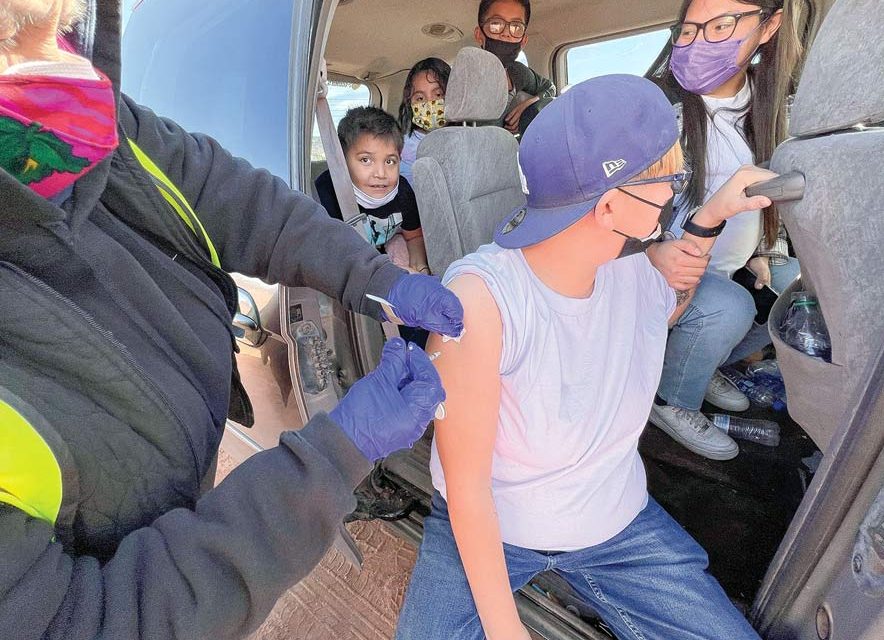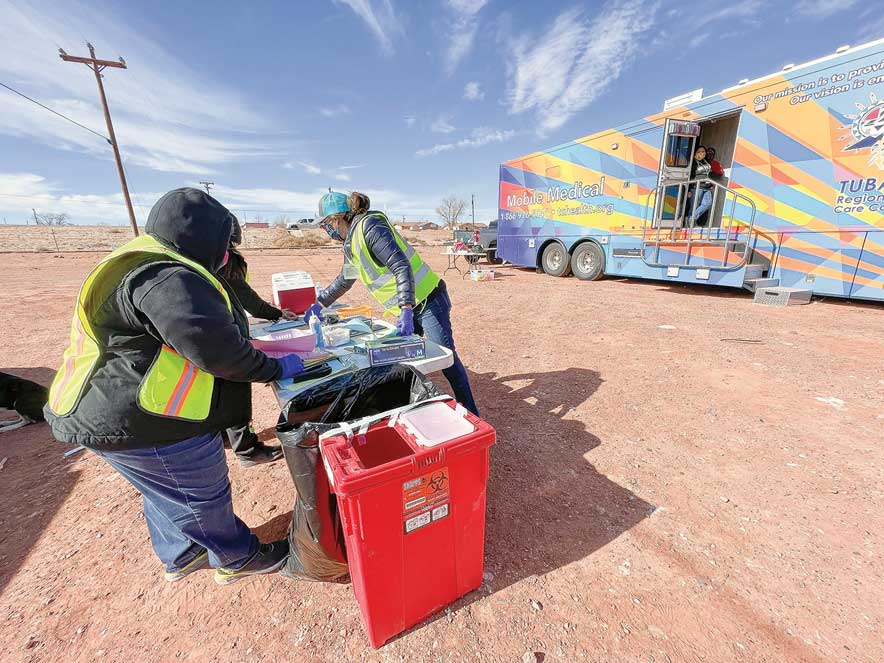
Redefining community health: Diné get free boxes of N95 at mobile vaccine clinic

Navajo Times | Krista Allen
A vaccinator from Tuba City Regional Health Care Corporation inoculates Gasha Johnson, 25, during the hospital’s drive-thru vaccine clinic in Kaibeto, Ariz., on Jan. 29.
K’AI’BII’TÓ, Ariz.
Two years into the coronavirus pandemic, Diné who’ve had a hard time getting their hands on legitimate N95 particulate respirators and hand sanitizers are finally getting them.
Courtesy of taxpayers and the Nez administration, many Diné families have already gotten their boxes (20-count) of N95 and liters of hand sanitizers free of charge at several COVID-19 vaccine/booster clinics across Navajoland.
Those families also received boxes (50-count) of three-ply face masks, packages of non-medical cloth face coverings, and gallons of Clorox disinfecting bleach as a bonus.
President Jonathan Nez last week said some of the items are from the tribe’s health command operations center.
The hand sanitizers, N95s, face coverings, and masks are manufactured by Equate, 3M, Cardinal Health, and China factories that make masks, respectively. The Department of Health purchased the items through its executive director, Jill Jim.
Others were purchased with donations, the Coronavirus Aid, Relief, and Economic Security Act, and Indian Health Service funding. And some hand sanitizers are from World Vision, a global Christian humanitarian organization.
“These are items that go into isolation kits,” Nez explained. “There are a lot of mixture of items.
“We want to clear out Nakai Hall at the fairground in Window Rock so we can start boxing food again,” he said.
Nakai Hall is nearly empty now.
Nez said he and his staff gave away quality personal protective equipment at COVID-19 vaccine/booster clinics to attract unvaccinated people. And it works.
“People are getting vaccinated,” Nez said.
Because this vaccine incentive hasn’t been offered before on this scale, no existing data points to which reward (N95 vs. hand sanitizer vs. Clorox) is more effective at increasing vaccination rates than others.
Masks and COVID-19
Before the coronavirus pandemic, one probably never considered the differences between a cloth face covering, a surgical mask, a face mask, and an N95.
But COVID-19 has created a new reality where face coverings are part of daily life.
The Centers for Disease Control and Prevention recently clarified its stance on various masks, acknowledging that the cloth face coverings do not offer as much protection as surgical masks and particulate respirators.
High-quality masks such as N95, KN95, and KN94 are made with layers of high-tech filtering material that trap at least 95% of airborne particles, including those that may contain viruses and bacteria.
This means that respirators can help protect a wearer while they breathe in, according to 3M’s website.
Cloth and single-use surgical/face masks help protect those around a wearer when they talk, cough, and sneeze. Because masks fit loosely on the face, they don’t provide as much respiratory protection from germs or contaminants to the wearer because fine particles in the air can leak around the edges.
An N95 respirator – or similar respirator – is intended to seal tightly to the face, covering the mouth and nose. The entire surface of the respirator is a filter, which makes it efficient at capturing airborne particles.
Surgical masks and particulate respirators were in short supply early in the pandemic. Now the problem is there are many different masks for sale, and it’s tough to know which ones have been tested and certified by government agencies and which are counterfeit.
The CDC changed its guidelines last month to recommend that people “wear the most protective mask you can that fits well and that you will wear consistently.”
The updated guidelines came after many public health experts recommended that people wear more effective masks and that the agency change its guidelines on mask-wearing. The change came as infections with the highly contagious Omicron variant continued to soar.
Vaccination clinic, new mobile health

Navajo Times | Krista Allen
Vaccinators and public health technicians work at a table outside Tuba City Regional Health Care Corporation’s new mobile health, during a drive-thru vaccine clinic in Kaibeto, Ariz., on Jan. 29.
Gasha Johnson, 25, received a dose of the Pfizer-BioNTech COVID-19-vaccine while her young siblings, who also received their shots, watched from inside a minivan.
Johnson looked away as a vaccinator from Tuba City Regional Health Care Corp. administered a vaccine in front of the hospital’s new mobile medical van – a Freightliner designed by Farber Specialty Vehicles.
TCRHCC has been running vaccine clinics within the Tuba City Service Unit Area since the COVID-19 vaccine became available in early 2021.
The coronavirus arrived in Diné Bikéyah nearly two years ago. The first case was identified March 17, 2020, and cases soared in the Tuba City Service Unit Area shortly after that, said Dr. Amanda Burrage, a pediatrician at TCRHCC, where she’s a member of the epidemiology team.
Burrage, on Tuesday morning, said, “We’re starting to see a decline in this surge of Omicron, but with other variants, we still have a long way to go.”
Omicron now accounts for more than 99.5% of new infections in the U.S., according to estimates from the CDC. Omicron moves fast, spreads swiftly through populations, and infections develop quickly in individuals.
Burrage said the most important weapon for fighting the pandemic at this point is still prioritizing the COVID-19 vaccine – both the first two shots in the primary series and the booster vaccine.
“I worry a lot about unvaccinated individuals,” she said. “The virus is infecting all ages, so it’s very important that all ages get vaccinated and boosted, including young adults and pediatric patients. We hope the vaccine will be available to children less than 5 years old in the near future.
“The great news is that the vaccine is still very effective at preventing severe illness, including hospitalization and death,” she added. “I’m glad we have more than half our population vaccinated, but we still have many unvaccinated people who are vulnerable to severe illness from COVID-19.”
To improve health care access and to provide vaccination clinics in communities within the Tuba City Service Unit, providers are traveling to those communities.
On Dec. 16, 2021, the hospital unveiled its new 45-foot-long, custom-built mobile health van, which was in Kaibeto on Jan. 29.
“We acquired a new medical mobile unit – state of the art,” said Joe Baca, a health-care social worker at TCRHCC’s community counseling center. “And it’s a lot bigger than our other (two) units.
“It’s good,” Baca said. “Something the communities can benefit from. Things like the (vaccine clinics) and other medical issues that people need to address – they don’t have to go all the way to the hospital.”
He added, “We come out here and do what we can to (serve) the communities, giving a whole new definition of community health.”
As a public service, the Navajo Times is making all coverage of the coronavirus pandemic fully available on its website. Please support the Times by subscribing.
How to protect yourself and others.
Why masks work. Which masks are best.
Resources for coronavirus assistance








 Highway 264,
Highway 264, I-40, WB @ Winslow
I-40, WB @ Winslow